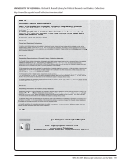76 · Survey Results: Survey Questions and Responses
special subject areas.”
“Usually, a collection description is added when the processing is complete. Occasionally a brief description will
be added before this is done with a statement such as ‘not cataloged’ or ‘cataloging in process.’”
“We are adding new collections as they are accessioned or processed. Some legacy finding aids have been added,
but our focus is on newly-collections.”
“We are working towards doing this for every manuscript collection as long as we have some intellectual
control of the collection. Whether this is done now depends on staff time and the existence of the necessary
information.”
“We cannot answer this question because the information is very scattered, given the decentralization of special
collections programs here.”
“We only put information on the Web for those collections that pass minimal-level scrutiny. As long as the title,
extent, inclusive dates, and abstract are accurate, the collection meets the criteria.”
“We use our Web site as our collection management tool as soon as a collection is received, appraised and
accessioned it is given a short one paragraph summary description. If importance and complexity of the collection
warrants it we do a more fulsome finding aid such as a partial or full-blown inventory.”
“When we converted our legacy finding aids from word processing files, we had 95 finding aids that only had
RLIN records and so were not converted. We have begun to add these to our Web site using an XML template in
NoteTab to produce the EAD. To date we have input 43 of the records.”
Finding Aids on the Web
18. Are finding aids included on the Web site? N=64
Yes 60 94%
No 4 6%
If yes, how many finding aids currently are on the Web site? N=56
Minimum Maximum Mean Median Std Dev
1 6,000 655 290 1,182.85
special subject areas.”
“Usually, a collection description is added when the processing is complete. Occasionally a brief description will
be added before this is done with a statement such as ‘not cataloged’ or ‘cataloging in process.’”
“We are adding new collections as they are accessioned or processed. Some legacy finding aids have been added,
but our focus is on newly-collections.”
“We are working towards doing this for every manuscript collection as long as we have some intellectual
control of the collection. Whether this is done now depends on staff time and the existence of the necessary
information.”
“We cannot answer this question because the information is very scattered, given the decentralization of special
collections programs here.”
“We only put information on the Web for those collections that pass minimal-level scrutiny. As long as the title,
extent, inclusive dates, and abstract are accurate, the collection meets the criteria.”
“We use our Web site as our collection management tool as soon as a collection is received, appraised and
accessioned it is given a short one paragraph summary description. If importance and complexity of the collection
warrants it we do a more fulsome finding aid such as a partial or full-blown inventory.”
“When we converted our legacy finding aids from word processing files, we had 95 finding aids that only had
RLIN records and so were not converted. We have begun to add these to our Web site using an XML template in
NoteTab to produce the EAD. To date we have input 43 of the records.”
Finding Aids on the Web
18. Are finding aids included on the Web site? N=64
Yes 60 94%
No 4 6%
If yes, how many finding aids currently are on the Web site? N=56
Minimum Maximum Mean Median Std Dev
1 6,000 655 290 1,182.85








































































































































































































